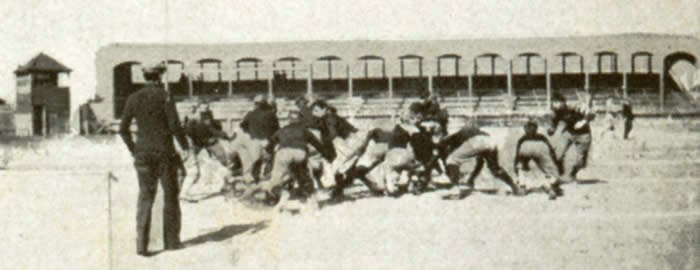
Hampton Park Stadium 1907

General Johnson Hagood Memorial Stadium
When The Citadel played Furman at Hampton Park in the fall of 1926, there was such a tremendous crowd of people at the game that the stands and bleachers were unable to accommodate them. Some of the people had to stand up during the entire game, and the stands, where a good many sitting, were in such a dilapidated and worn-out condition that they became dangerous to the safety of their occupants. Right then and there the people of Charleston, and especially Mayor Stoney and Fritz Von Kolnitz, saw the crying need of a municipal stadium, of a larger and more modern sports arena for the City of Charleston. Hampton Park, the former home of the Sally League Baseball Club, would no longer fill the requirements for the of a city as large as Charleston.
The athletics of The Citadel were concerned in the plans for building of a new stadium. Hertoafter, all football and baseball games of The Citadel had been played at Hampton Park, and up until the recent startling growth of interest in athletics at The Citadel, the “park” had been adequate for the needs of the school and the comfortable seating of the crowds.
But with the coming of Prause and the “Bantams,” the scope of athletics at The Citadel began to broaden; more interest was taken in football and baseball; and larger and larger became the crowds that attended athletic contest in which The Citadel took part.
Mayor Stoney, in speaking to the corps of cadets at the football banquet in the spring of 1927, cited the need of the City of Charleston for a municipal stadium. He cited, too, the interest that the people of Charleston were taking in The Citadel, and spoke of the broadening of the various branches of sports at this institution. He concluded his speech by saying, “When Don Blanding leads The Citadel Bulldogs on the gridiron in Charleston this fall, he will lead them into a new, modern municipal stadium and not into Hampton Park.” These words were gladly heard by the members of the cadet corps, and Mayor Stoney was loudly and lengthily applauded for his kind and prophetic speech.
It was with much gratification that the men and supporters observed the almost immediate execution of Mayor Stoney’s plans. The bill providing for the building of the stadium having been passed by the City Council with little opposition, the site was chosen at the corner of Congress and Parkwood streets. During the summer months the steel structure forming the bowl was erected on three sides of the playing field, bleachers from Hampton Park being placed on the remaining side. Drains were put in, and the ground was worked to the best possible condition. Grass was planted on the playing field, and although it did not grow much extent by fall, it should put the gridiron in excellent condition by the next football season.
The new General Johnson Hagood Memorial Stadium, as the stadium was named, was dedicated October 15, 1927, with a brief ceremonies preceding The Citadel-Oglethorpe football game. More than six thousand persons saw the two hundred invited guest march upon the field and heard a short dedication address by Mayor Thomas P. Stoney.

Invited Guest to Dedication of JH – 1927
In his brief address, Mayor Stoney said that in the dedication of the stadium there was a two fold-purpose. The first purpose was that of paying a tribute and regard for one whose name will long be remembered, General Johnson Hagood, great leader of the Confederacy. The second was that of presenting to the youth of Charleston a medium through which might be manifested their devotion to the ideals of sportsmanship.
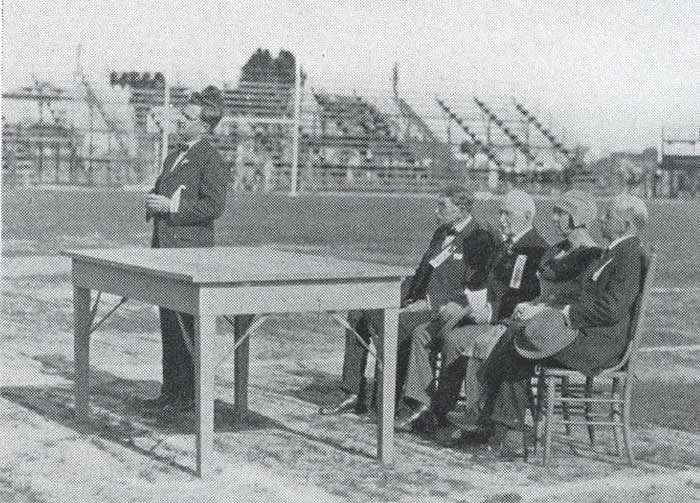
Mayor Stoney Dedication Speech
General Johnson Hagood was graduated at The Citadel at the age of sixteen with highest honors. He entered the service of the Confederate States of America in 1861, with the rank of colonel of volunteers. He took part in the bombardment of Fort Sumter in April of that year and rendered conspicuous service at the battle of Bull Run. He later became Governor of South Carolina.
Since the dedication, work has progressed to further the aims of the stadium to fit many purposes. Tennis courts have been laid out; a track, which is later to be cindered, has been built; a baseball diamond has been laid out; and horse sheds have been built with the view of having horse racing.
The new stadium suffices for all the needs of Charleston and The Citadel. Not only will it stand as a memorial to the memory of a great General, but it will be a perpetual memorial to the memory of those people of Charleston who made its erection and contributed their time and energy for its good.
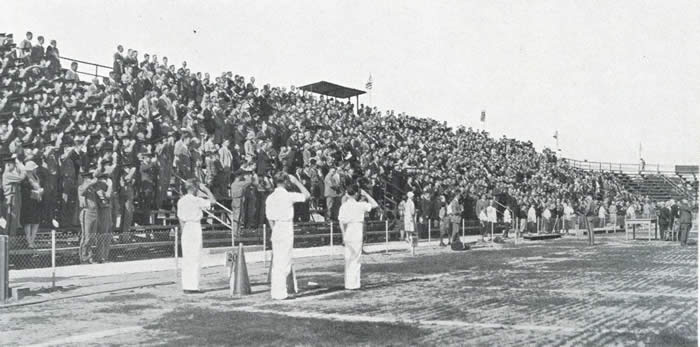
Presenting the Colors at Dedication-1927
Article from the 1928 Sphinx
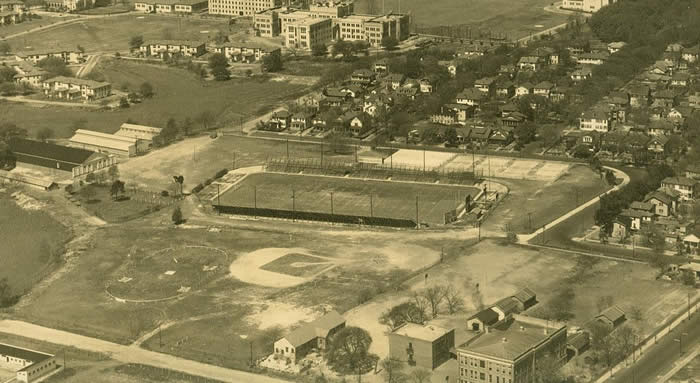
Aerial View of Johnson Hagood Stadium – circa 1939
Johnson Hagood “One” had served the City of Charleston and The Citadel well for almost twenty years but it was decided by the “city fathers” and the leadership at The Citadel that a modern venue for events be constructed. The City of Charleston selected Halsey & Cummings Architectural Firm of Charleston to design the Second Johnson Hagood Stadium and ground was broken in 1946. The direction of the field would be changed from the original Johnson Hagood from east-west to north-south. The seating capacity would more than double from 10, 000 to 22,000. The total cost of project was $600,000, which would equate to $5.8 million in 2012 dollars. In 1963 The Citadel purchased JHS from the city for $250,000.
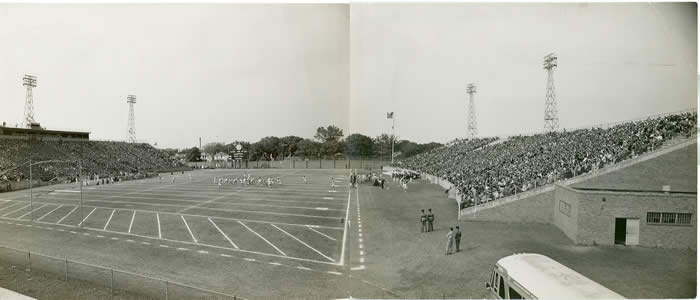
Johnson Hagood Stadium II
The first game played in new complex was on October 16, 1948 vs Davidson with a 14-6 defeat. The official dedication was on December 04 vs. Clemson (0-20). The first victory for the Bulldogs in the “new” Johnson Hagood would be the first home game of the 1949 season on October 12 with a 14-12 win over Newberry. The “dogs” would go on and post a 3-2 home record that year.
Over the next 58 years this facility and surrounding area would serve the city and The Citadel with many memorable events which would include not only Bulldog football games but the Low County Fair, concerts, the Sertoma Football Jamborees, high school band contest, the 1983 & 1984 NCAA Division 1-AA National Championship games (now known as the Football Championship Subdivision) plus many more events.
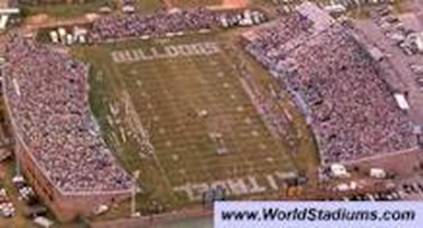
Johnson Hagood Stadium Aerial View
During this period Citadel football would establish many great accomplishments. One of largest was the 0 to 0 tie against Florida State in 1960. The bulldogs would have five undefeated seasons (1959, 1978, 1980, 1981 and 1988) plus reeling off sixteen (16) consecutive home victories from 1980 to 1982. The 1978-1980-1981 season and consecutive wins came under the direction of Coach Art Baker. Also two Southern Conference Championships (1961 and 1992) would take place during this period with a total of 309 games being played with the “dogs” winning 189 contest for a 61% winning percentage.
The following shows the top 10 crowds at Johnson Hagood during this 58 year period.
| CROWD | OPPONENT | DATE | SCORE | COACH |
| 23,025 | Marshall | Oct. 17, 1992 | 13 – 34 | Taaffe |
| 21,623 | Furman | Nov. 23, 1991 | 10 – 6 | Taaffe |
| 21,575 | Davidson | Oct. 25, 1969 | 34 – 28 | Parker |
| 21,570 | Delaware | Sep. 18, 1976 | 17 – 15 | Ross |
| 21,465 | Presbyterian | Sep. 13, 1975 | 21 – 0 | Ross |
| 21,460 | William & Mary | Oct. 11, 1969 | 14 – 21 | Parker |
| 20,863 | Wofford | Nov. 01, 2003 | 16 – 42 | Johnson |
| 20,754 | Navy | Sep. 24, 1988 | 42 – 35 | Taaffe |
| 20,592 | Furman | Nov. 16, 1985 | 0 – 42 | Moore |
| 20,357 | Furman | Nov. 18, 1989 | 9 – 44 | Taaffe |
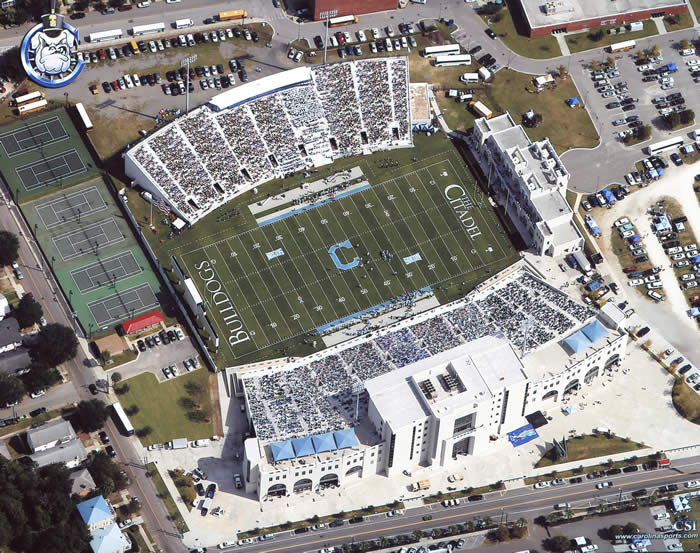
Aerial view of Johnson Hagood-2011
